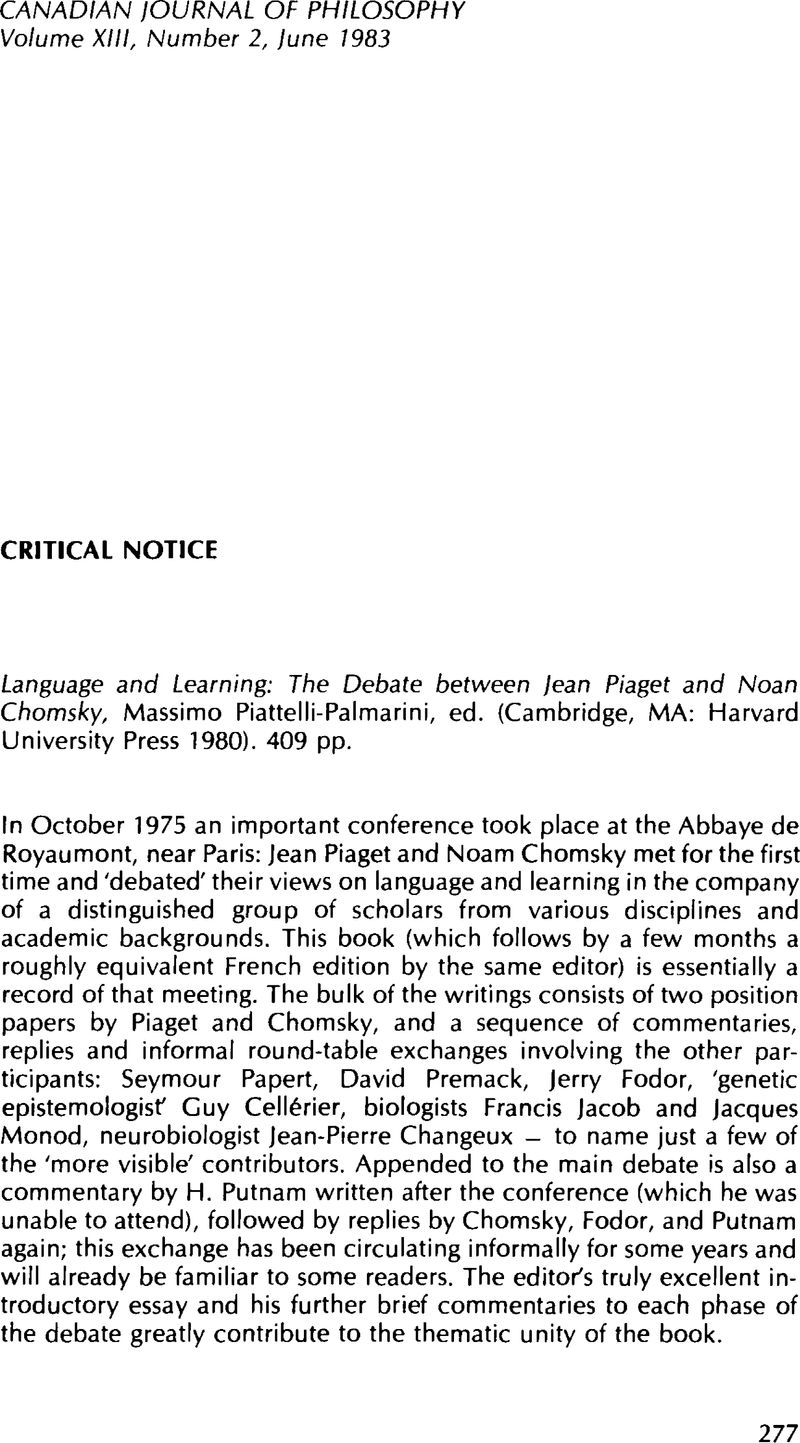Published online by Cambridge University Press: 01 January 2020

1 Since the formation of the ‘fixed nucleus’ precedes language acquisition, the rationa I structure in question cannot literally be a linguistic structure. What Piaget must mean by ‘linguistic’ here is ‘language like’ or ‘language relevant’ or, more generally, ‘symbolic.'
2 The argument is summarized on p. 31. A second argument is hinted at later but not adequately developed (58, 60): it rests on the claim that ‘there is no clear and total opposition between what is innate and what is acquired’ (60), from which one can presumably infer that the innateness hypothesis is not a methodologically sound or fruitful hypothesis.
3 Piaget does not rule out the possibility that FN might have developed through some alternative evolutionary process: ‘But let us suppose now that this innateness is demonstrated …. In that case, I would answer that this is not a random mutation, but that the only possible explanation would have to be sought in the direction of phenocopies …’ (59) (Piaget's concept of ‘phenocopy’ is explained below, in section 3.)
4 I already remarked on the Kantian legacy in Piaget's constructivism. This legacy is brought out in the debate by Piaget's recurring criticism of K. Lorenz, ‘who considers himself a Kantian’ (30) but who, according to Piaget, really betrays Kantism, for he reduces Kant's a priori forms to ‘a mere collection of working hypotheses.’ Thus Lorenz, ‘while retaining the point of departure of the a priori (which precedes the constructions of the subject). sets aside necessity which is more important, whereas we are doing exactly the opposite, that is, insisting on necessity … but placing it at the end of constructions, without any prerequisite hereditary programming’ (30, my emphasis).
5 ‘I absolutely refuse, for my part, to think that logico-mathematical structures could owe their origin to chance; there is nothing fortuitous about them. These structures could not be formed by survival selection but by an exact and detailed adaptation to reality’ (59)
6 ‘One can see, then, how equilibration leads to logical necessity: the progressive coherence, sought and finally attained by the subject … achieves a comprehension of linkings or implications that have become deductible and thereby necessary’ (32). ‘Logical necessity’ I take here to be a misnomer; ‘deductibility,' here, can only be relative to a theory about an empirical system.
7 Chomsky would probably accept the necessity of FN in this sense, for he conceives of FN as a (genetically encoded) system of universal grammar, not as a disjointed set of structures; cf. p. 124, where he stresses that a description of the initial state S0 (thus FN) forms a ‘highly integrated theory.'
8 In a paper published in 1973 Waddington discusses a study of Piaget's on various species of Limnea, which Piaget repeatedly cites in the debate to illustrate genetic assimilation and the phenocopy phenomenon (60ff.). Waddington uncompromisingly rejects Piaget's interpretation of the facts as involving a ‘Lamarckian-type action’ of the environment on the genotype (Waddington, C.H. The Evolution of an Evolutionist [Ithaca, NY: Cornell University Press 1975], 92-5Google Scholar).
9 Piaget's grasp of Chomskian linguistics and of Chomsky's theoretical grounds for the innateness hypothesis is very tenuous indeed. He declares himself in agreement with Chomsky on the ‘essential’ and ‘fundamental’ points. One of these points, which he takes to be Chomsky's ‘main contribution to psychology,’ is that 'language is the product of intelligence and reason’ (57; cf. 167). He also finds himself in agreement with Chomsky ‘regarding the partial constructivism of his works, that is, the transformational grammars’ (57). Elsewhere he identifies Chomsky's ‘fixed innate scheme’ (that is, Chomsky's UG) with ‘kernels’ and ‘deep structures’ (Structuralism [New York 1970], 88). Obviously Piaget did not do his homework before leaving for Royaumont.
10 Actually SSC does not appear to be valid. As formulated here it would block the perfectly valid transformation from ‘Each of the men expects to like the others' (where ‘the others’ occurs in object, not in subject position) to ‘The men expect to like each other.’ (I owe this example to my student David Davis.) Moreover, according to Chomsky (40) anaphoric transformations sanctioned by SSC should be meaning preserving; if the above transformation were sanctioned by SSC so would the following, which is not meaning preserving: ‘Each of the contestants hopes to outdo the others’ - ‘The contestants hope to outdo each other.'
11 Putnam challenges it, but his contribution occurred after the debate. As he puts it, ‘the grammar of a language is a property of the language, not a property of the brain of Homo sapiens’ (290). Chomsky's assumption is also challenged, by implication, in Papert's discussion of the ‘perceptron’ (93ff.).
12 For a lucid and detailed discussion of this point see Stabler, E.P. Issues in the Foundations of Cognitive Psychology, unpublished Ph.D. thesis, MIT, 1981.Google Scholar
13 Chomsky has argued that such semantically based grammars are mere ‘notational variants’ of his own. I think this claim is extravagant: the most he can claim is that they are observationally and (perhaps) descriptively equivalent to his own, but certainly not explanatorily equivalent: they may play different roles in theories of language use and language acquisition. (Cf. Chomsky on ‘explanatory adequacy,’ Aspects of the Theory of Syntax, ch. 1.)
14 Of course children do not learn any such thing (except perhaps in school); they learn to make statements and to ask questions.
15 A variety of proposals on the sorts of semantic relations operative in early language learning is presented in Brown, Roger A First Language (Cambridge, MA: Harvard University Press 1973)Google Scholar.
16 In Miller, G.A. and Lenneberg, Elizabeth eds., Psychology and Biology of Language and Thought: Essays in Honor of Eric Lenneberg (Academic press 1978), 279Google Scholar and 197, respectively.
17 I am grateful to SSHRCC for support in this research.